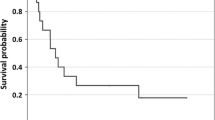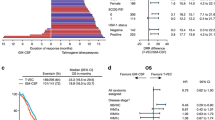Abstract
The inflammatory tumor lymphocytic infiltrates and spontaneous tumor regressions seen in patients with metastatic malignant melanomas suggest a cellular immune involvement. Enhancement of such responses has been the goal of R24 (GD3 ganglioside-specific) monoclonal antibody trials, alone and in combination with other agents. This study reports the results of 21 patients treated in a phase IB trial employing R24 (0, 5, 25, 50 mg/m2) administered by continuous i.v. infusion on days 1–5 followed by 3mU each of interleukin-2 (IL-2) and alpha interferon (α-IFN) given subcutaneously on days 8–12, 15–19 and 22–26. R24-related toxicities occurred pre-dominantly at the 25 and 50 mg/m2 doses. One patient (50 mg/m2 R24) exhibited a dose-limiting Grade 4 anaphylaxis. Cytokine-related toxicities required IL-2/α-IFN dose reduction in two patients and early termination of treatment in five additional patients. Nine of 20 baseline biopsies showed chronic inflammation; six with lymphocytic tumor infiltration and three where inflammation was confined to the perivascular/ peritumoral spaces. No day 8 or 29 biopsies in the R24-treated groups demonstrated treatment-induced tumor lymphocytic infiltrates. However, one patient randomized to no R24 treatment, showed a significant inflammatory tumor lymphocytic infiltration at days 8 and 29. Eighteen of 21 treated patients were evaluable for response. One (5%) patient receiving IL-2/α-IFN alone had stable disease lasting 1.5 years. Five (28%) R24, IL-2/α-IFN-treated patients had stable disease ranging from 6 to 32 weeks, with one patient remaining alive 2.5 years post-treatment. Although this combined treatment program was generally well tolerated, no objective responses were seen and significant R24-induced tumor lymphocytic infiltrates were not demonstrated.
Similar content being viewed by others
References
Houghton ANet al. Mouse monoclonal IgG3 antibody detecting GD3 ganglioside: A Phase I trial in patients with malignant melanoma.Proc Natl Acad Sci USA 1985;82: 1242.
Vadhan-Raj Set al. Phase I trial of a mouse monoclonal antibody against GD3 ganglioside in patients with melanoma: Induction of inflammatory responses at tumor sites.J Clin Oncol 1988;6: 1636.
Caulfield MJet al. Phase Ia–Ib trial of an Anti-GD3 monoclonal antibody in combination with Interferon-α in patients with malignant melanoma.J Biol Res Modifiers 1990;9: 319.
Bajorin DFet al. Phase I evaluation of a combination of monoclonal antibody R24 and interleukin 2 in patients with metastatic melanoma.Cancer Res 1990;50: 7490.
Casper ESet al. Biological study of R24 mouse monoclonal antibody in patients undergoing thoracotomy for pulmonary metastases from soft tissue sarcoma.Cancer Invest 1994;12:20.
Minasian LMet al. Hemorrhagic tumor necrosis during a pilot trial of tumor necrosis factor-α and anti-GD3 ganglioside monoclonal antibody in patients with metastatic melanoma.Blood 1994;83: 56.
Bukowski RMet al. Phase I trial of cisplatin, WR-2721, and the murine monoclonal antibody R24 in patient with metastatic melanoma: Clinical and biological effects.J Immunother 1994;15: 273.
Chachoua Aet al. Phase Ib trial of granulocyte-macrophage colony-stimulating factor combined with murine monoclonal antibody R24 in patients with metastatic melanoma.J Immunother 1994;16: 132.
Minasian LMet al. A Phase I study of anti-GD3 ganglioside monoclonal antibody R24 and recombinant human macrophage-colony stimulating factor in patients with metastatic melanoma.Cancer 1995;75: 2251.
Real FXet al. Surface antigens of melanomas and melanocytes defined by mouse monoclonal antibodies: Specificity analysis and comparison of antigen expression in cultured cells and tissues.Cancer Res 1985;45: 4401.
Hersey Pet al. Potentiation of lymphocyte responses by monoclonal antibodies to the ganglioside GD3.Cancer Res 1986;46: 6083.
Welte Ket al. Stimulation of T lymphocyte proliferation by monoclonal antibodies against GD3 ganglioside.J Immunol 1987;139: 1763.
Claus Cet al. Inhibition of anti-GD3-ganglioside antibody-induced proliferation of human CD8+ T cells by CD16+ natural killer cells.Eur J Immunol 1994;24: 1208.
Norihisa Yet al. Increased proliferation, cytotoxicity, and gene expression after stimulation of human peripheral blood T lymphocytes through a surface ganglioside (GD3).J Immunol 1994;152: 485.
Boussiotis VAet al. R24 anti-GD3 ganglioside antibody can induce co-stimulation and prevent the induction of alloantigen-specific T cell clonal anergy.Eur J Immunol 1996;26: 2149.
Goedegebuure PSet al. Adoptive immunotherapy with tumor-infiltrating lymphocytes and interleukin-2 in patients with metastatic malignant melanoma and renal cell carcinoma: A pilot study.J Clin Oncol 1995;13: 1939.
Kawakami Yet al. Recognition of multiple epitopes in the human melanoma antigen gp100 by tumor-infiltrating T lymphocytes associated within vivo tumor regression.J Immunol 1995;154: 3961.
Weiner LMet al. Phase I evaluation of combination therapy with interleukin-2 and γ-interferon.Cancer Res 1991;51: 3910.
Creagen ETet al. Disseminated malignant melanoma and recombinant interferon: analysis of seven consecutive Phase II investigations.J Invest Dermatol 1990;95: 1885.
Parkinson DRet al. Interleukin-2 therapy in patients with metastatic malignant melanoma: a Phase II study.J Clin Oncol 1990;8: 1650.
Leagha SS. Interferons in the treatment of malignant melanoma. A review of recent trials.Cancer 1986;57: 1675.
Weiner LMet al. Binding and cytotoxicity characteristics of the bispecific murine monoclonal antibody 2B1.J Immunol 1993;151: 2877.
Valone FHet al. Phase Ia/Ib trial of bispecific antibody MDX-210 in patients with advanced breast or ovarian cancer that overexpress the proto-oncogene HER-2/neu.J Clin Oncol 1995;13: 2281.
Author information
Authors and Affiliations
Rights and permissions
About this article
Cite this article
Alpaugh, R.K., von Mehren, M., Palazzo, I. et al. Phase IB trial for malignant melanoma using R24 monoclonal antibody, interleukin-2/α-interferon. Med Oncol 15, 191–198 (1998). https://doi.org/10.1007/BF02821938
Received:
Accepted:
Published:
Issue Date:
DOI: https://doi.org/10.1007/BF02821938




